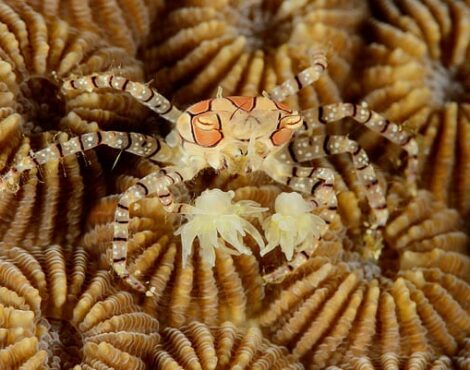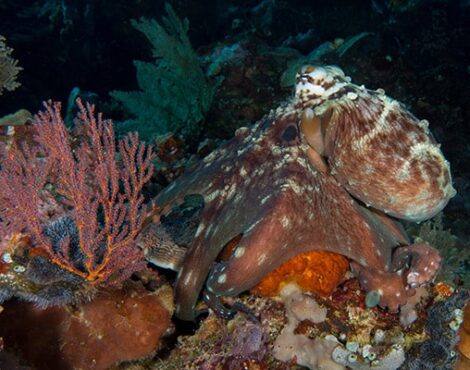Cephalopods: Discover the Fascinating World of Octopus, Cuttlefish, Squid, and More in North Sulawesi’s Waters.
Cephalopods are a class of marine molluscs that includes over 800 species of octopus, cuttlefish, squid, nautilus and bobtail squid, and a further 11,000 extinct species have been described. They are found in all of the oceans on Earth, however there is no species known to be able to tolerate fresh water. They can be found living from the shallow intertidal zone, all the way down to the abyssal plane, with the highest concentration living in the tropics. Indonesia, being part of the coral triangle (the world’s top marine biodiversity hotspot) naturally has a wide variety of different species, however as North Sulawesi sits directly at the heart of the coral triangle, it is a treasure trove for divers and snorkelers looking to get a glimpse at some of these fascinating creatures. The steep walls and sandy slopes throughout Bunaken Marine Park are home to a huge variety of different cephalopod species, and due to the extreme depths found within the park, there may be many more species living here than we know about.
Intelligence and Chromatophores: Unique Traits of Cephalopods
They considered to be the most intelligent invertebrates, often being able to solve complex puzzles, and they have good senses with large brains. Most species have chromatophores – cells with multiple colours that they can use in a number of different ways, from blending into their surroundings to avoid predation, dazzling their prey, to communicating with a potential mate. Their colouration can be changed in only milliseconds to completely camouflage themselves, although this kind of behaviour is more common in species found near the shore, where there is substrate to hide amongst.
Size Variations: From Tiny Pygmy Squids to Colossal Squids
Cephalopods range enormously in size, from tiny pygmy squids barely reaching more than 1cm, to the fearsome colossal squid whose total length can exceed 10 metres, weighing in at over half a tonne! Such enormous creatures are rarely spotted, leading to them being depicted as sea monsters capable of pulling large ships underwater. Now we know these stories to be untrue, however almost every ocean going civilisation around the world has folklore of such beasts terrorising sailors. What is perhaps more impressive than the size range between different species, is the range in size between the different sexes of the same species. Male dwarfism, which occurs in many octopus species, is where the fully developed female is multiple times larger than the fully developed male. A good example of this blanket octopuses, where an adult male may reach only a maximum of 2.5 cm, while the female may reach a total length of 2m, weighing up to 40,000 times heavier than her mate.
Underwater Photography Favorites: Blue Ringed Octopus and Flamboyant Cuttlefish
The diversity among cephalopods make them a favourite for underwater photography. The docile yet potentially deadly blue ringed octopus are among the most popular, with their bright yellow bodies and contrasting neon blue rings. While difficult to find due to their small size, they are not uncommon, and are a highlight on many night dives whilst diving in Bunaken Marine Park. The aptly named flamboyant cuttlefish is another fan favourite, often displaying bright colourations to warn predators of their toxic flesh. Unlike many other cuttlefish species, they are usually most active during the day, and can be found using their lower arms to walk along the blacks sands of the muck diving sites along the Sulawesi coastline.
Curious Reef Octopus and Memorable Dive Encounters
Bigger reef octopus are found all over the park, both during the day and night. As they are quite shy, they can be difficult to get close to for photographing, however their inquisitive nature makes them great video subjects, as they are often too curious to hide away for long, often poking their heads out of their dens to see if you are still there.
Mesmerizing Cephalopod Behaviors: Squid Laying Eggs and Cuttlefish Hunting
Other behaviour by cephalopods can make some extremely memorable dive experiences. Recently we have been having many squid laying eggs on some of our favourite muck diving sites. Although difficult to approach for photographing, leaving a video camera on near the action can produce wonderful footage you would expect to see on a nature documentary. At night you can also see cuttlefish hunting, and again if you are filming you may be lucky to capture them extending their two arms as they go in for the kill, a movement that is only a blur to the naked eye.




